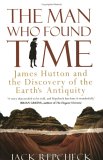Summary | Excerpt | Reviews | Readalikes | Genres & Themes | Author Bio

Critics' Opinion:
Readers' Opinion:
First Published:
Apr 2003, 256 pages
Paperback:
Jul 2004, 256 pages
Since giving the public lectures, Hutton had been
remarkably successful in finding convincing proof that extreme
subterranean heat was an active agent in the formation of the continents.
Although this finding alone was significant, it did not necessarily follow
that intense heat had led to the raising of new land above the oceans to
replace the eroded land of former regions. Hutton needed to find an
exposure of rocks that somehow demonstrated his theorized cycle.
Discovering such an outcrop was the quest of the three
sailors as they plied the waters of the North Sea. Hutton had chosen to
investigate here because he knew that this part of Scotland had two
distinct types of surface rock. What was believed to be the older of the
two was a smooth, grayish stone that mineralogists labeled "primary
micaceous schistus" (today it is called Silurian graywacke)—a type of
shale. The other, younger rock, a coarse reddish stone, Hutton called the
"secondary sandstone strata" (today it is called the Upper Old Red
Sandstone). The doctor was convinced that the two rock groups represented
two separate erosion-sedimentation-uplift cycles, and that at some
location the younger rock (the coarse red sandstone) must come in contact
with, and actually cover, the older rock (the gray smooth stone). There
was a chance that the junction of the two formations would be visible on
the coast, thanks to the intense erosion inflicted by the pounding winds
and water of the North Sea.
The men could conceivably have avoided using the boat, and
the attendant risk of the sea, by hiking along the coast. However, it was
so rugged—there were ravines to cross, steep rock faces to climb, and
hills to circumnavigate—that it would have taken days to see everything
they were hoping to see on this one day. Besides, Hutton was too old to
conduct the exploration by land.
After leaving the spot where they boarded the boat, the
Dunglass Burn beach, they sailed along a jagged coastline. The mild
weather and low tide allowed them to sail near the shore, and the early
afternoon sun gave maximum exposure to the cliffs on their right. The
rocks were from 50 to 70 feet high, grass and moss covering the tops. The
relentless pummeling by the North Sea gave the sharp juttings an ominous,
almost clawlike shape.
About a half mile from Dunglass Burn, the boat came to the
first headland, Reed Point. The explorers rounded the point but could
detect no unusual formations from the boat; all that was visible was the
dominant primary schistus. Hutton decided not to land, and the boat
continued southward. They had to be extra careful along the next stretch
of coast because, in addition to the rugged cliffs, the waves broke
against large rocks protruding from the sea.
After several hundred yards, the boat skimmed past the next
headland, and the men turned their heads to witness a spectacular scene.
Pease Bay dug deeply into the coast and was marked by a beautiful sandy
beach stretching from end to end, at least 200 yards long. What was
striking was not the beach itself, but the rock formation that emerged
from it. Rising out of the sand, like a snake, was a beautiful red
sandstone outcrop, which seemed to burst out of the beach at a low
20-degree angle. The red rocks grew to form a 50-foot cliff. The formation
was covered with a thin coating of grass and moss, but enough had been
"cleaned" by the surf that the strata were clearly visible. These were
the secondary strata that Hutton was looking for. Still, as beautiful as
this exposure was, it did not contain the combination of rock layers that
Hutton hoped to find.
Excerpted from The Man Who Found Time by Jack Repcheck. Copyrighted by Jack Repcheck 2003, all rights reserved. No part of this book may be reproduced without written permission from the publisher, Perseus Publishing.





The Flower Sisters
by Michelle Collins Anderson
From the new Fannie Flagg of the Ozarks, a richly-woven story of family, forgiveness, and reinvention.

The House on Biscayne Bay
by Chanel Cleeton
As death stalks a gothic mansion in Miami, the lives of two women intertwine as the past and present collide.

The Funeral Cryer by Wenyan Lu
Debut novelist Wenyan Lu brings us this witty yet profound story about one woman's midlife reawakening in contemporary rural China.
Your guide toexceptional books
BookBrowse seeks out and recommends the best in contemporary fiction and nonfiction—books that not only engage and entertain but also deepen our understanding of ourselves and the world around us.